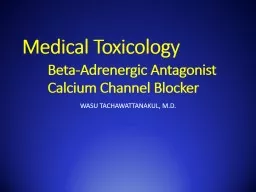

Calcium Channel Blocker WASU TACHAWATTANAKUL MD Objective Pharmacologic properties of betaadrenergic antagonist amp calcium channel blocker Clinical manifestation Management amp Antidote ID: 912799
Download Presentation The PPT/PDF document "Medical Toxicology Beta-Adrenergic Ant..." is the property of its rightful owner. Permission is granted to download and print the materials on this web site for personal, non-commercial use only, and to display it on your personal computer provided you do not modify the materials and that you retain all copyright notices contained in the materials. By downloading content from our website, you accept the terms of this agreement.
Slide1
Medical Toxicology Beta-Adrenergic Antagonist Calcium Channel Blocker
WASU TACHAWATTANAKUL, M.D.
Slide2ObjectivePharmacologic properties of beta-adrenergic antagonist & calcium channel blockerClinical manifestationManagement & Antidote
Slide3Beta-Adrenergic AntagonistMedical Toxicology
Slide4Beta adrenergic receptorβ1
Myocardium
, Kidney, Eye
β
2
Bronchial smooth muscle
, Liver,
vascular
, visceral smooth muscle
β
3
Adipose tissue, skeletal muscle
Slide5Slide6Beta-1 adrenergic receptoratMyocardium
Slide7Clinical manifestationCardiovascularDecreased contractility
Hypotension
Bradycardia
Conduction delay and block
Ventricular arrhythmia (
sotalol
)
Other
CNS depression, seizure, respiratory arrest
Bronchospasm
Hyperkalemia,
Hypoglycemia***
Slide8Example caseA 53 year old male is brought to the Emergency Department by ambulanceAt 20.45 he had taken an overdose of his beta blocker medication.
100 of his 40mg tablets of propranolol.
The ambulance was called at 21.01 and arrived at 21.21.
At scene the patient was found to be alert with a pulse rate of 54 and a blood pressure of 80/66.
Slide9At emergency departmentA: Stridor with minimal secretion in his mouth
B:
Minimal rhonchi, RR 10/min, SpO
2
92%
C:
BP 77/57 mmHg PR 54/min Cap. refill 3 sec
D:
E3V3M5 Pupil 2 mm RTLBE
E :
Temp. = 35.8˚C
Slide10After initial resuscitationAfter initial resuscitation was finished,he developed tonic-
clonic
seizure.
Management ?
Slide11Example caseSeizure was terminated by Diazepam IV but…the patient was found to be in PEA.
CPR was perform and return of spontaneous circulation occurred after 3mg of adrenaline.
Slide12After ROSC
A:
Endotracheal tube was insert properly.
B:
Minimal rhonchi, RR - ETT, SpO
2
99%
C:
BP 66/47 mmHg PR 34/min Cap. refill 4 sec
D:
E1VTM4 Pupil 4 mm SRTLBE
E :
Temp. = 35.8˚C
Management ?
Slide13Management of Beta blocker overdose
Glucagon
Adrenergic receptor agonist
Norepinephrine, Adrenaline
High-dose insulin therapy
Intravenous lipid emulsion therapy
Phosphodiesterase inhibitors
Milrinone
Calcium
Sodium Bicarbonate
Slide14Toxicokinetic of propranololAbsorption: Rapidly absorbed orally. Peak blood levels occur at 1-3 hours following oral administration.
Distribution
:
Highly lipophilic agent with a wide volume of distribution. Rapidly distributed to all tissues, including CNS.
Protein Binding
:
≈93% protein bound.
Slide15Toxicokinetic of propranololMetabolism: Hepatic metabolismElimination: 95-100% of an ingested dose is excreted in the urine as metabolites and their conjugates.
Half-life
: Plasma half-life ≈ 3-6 hrs. Elimination half-life is 12 hours and may be prolonged following overdose.
Slide16Glucagon
Glucagon increase cAMP; same as beta 1-adrenergic receptor
increase myocardial contractility
Slide17GlucagonAdult 3-5 mg/dose IV, may increase to 5-10mg next dose if no response.Pediatric 50mcg/kg/doseRepeat every 3-5 min until clinical improve.
After improved : continue IV drip 2-10mg/hr.
Monitor : hypo/hyperglycemia and hypokalemia
Slide18High-dose insulin therapyInsulin increased myocardial glucose uptake with subsequent increased contractility.Positive inotropic effect
Insulin therapy increased lactate uptake, most likely by restoring pyruvate dehydrogenase activity.
Slide19Insulin therapy increased lactate uptake, most likely by restoring pyruvate dehydrogenase activity.
Slide20Slide21High-dose insulin therapyInsulin : 1 U/kg IV bolus then IV continuous drip 0.5 U/kg/hr. titrate every 10-15min up to 2.5 U/kg/hr.Glucose : 50% dextrose 50 ml IV (Ped : 0.5g/kg) then 10% dextrose 100ml/hr.
(if CBG > 400mg% - No need for bolus dose)
Slide22High-dose insulin therapyMonitor CBG every 30 min until stable then every 1-2 hr. Keep CBG between 100-250 mg/dL
Monitor serum potassium
Keep 2.5-2.8
mEq
/L
Slide23Intravenous lipid emulsion therapyLipid sink phenomenonLipophilic substance are drawn into ‘lipid sink’
Indication
Local anesthesia
TCA
Beta blocker
Calcium channel blocker
Slide24Intravenous lipid emulsion therapy20% Intravenous lipid emulsion 1.5 ml/kg IV bolusThen 0.25 ml/kg/min (15ml/kg/
hr
)
Slide25Phosphodiesterase inhibitorsInhibit breakdown of cAMP
Sustaining intracellular calcium levels
Produce positive inotropic effects
Slide26Phosphodiesterase inhibitorsMilrinone50 mcg/kg IV bolus, Followed by an IV infusion of 0.375 to 0.75 mcg/kg/min
Slide27CalciumMay reverse depression of the myocardium via positive inotropic actionNot routinely recommended in β-blocker overdose10% calcium gluconate is 0.6 mL/kg given over 5 to 10 minutes, followed by a continuous infusion of 0.6 to
1.5 mL/kg/hr.
Slide28Sodium BicarbonateTreat wide QRS interval dysrhythmias secondary to sodium channel blockade.
Slide29Management of Beta blocker overdose
Slide30ProgressionHe was then transferred to cath lab for a pacing wire and transferred to ICUIn ICU, he was gradually weaned off the infusions. He continued to have intermittent seizures which were treated with diazepam.
He was discharged from the hospital 16 days after the OD
Slide31Slide32Calcium Channel BlockerMedical Toxicology
Slide33Cav-L open to allow calcium ion influx during myocyte depolarization
Concentration-dependent release of more calcium ions from sarcoplasmic reticulum
Cardiac contraction
Slide34Calcium Channel Blocker
Dihydropyridines : e.g. Nifedipine
Phenylalkylamines : e.g. Verapamil
Benzothiazines : e.g. Diltiazem
Slide35Mechanism/ToxicityIn myocardiumDecrease SA node activity & contractility, slowed AV conductionIn peripheral vascular system
Relaxation and vasodilatation
Slide36Mechanism/Toxicity
Dihydropyridines : e.g. Nifedipine
Major effect on peripheral vasculature
Phenylalkylamines : e.g. Verapamil
Major effect at SA node & AV node
Slide37Mechanism/Toxicity
Benzothiazines : e.g. Diltiazem
Intermediate activity at both cardiac
& peripheral vasculature
Slide38Clinical manifestationMild-Moderate toxicityDiltiazem, Verapamil Bradycardia, AV block, Hypotension
Nifedipine Reflex tachycardia, Hypotension
Severe toxicity
All can cause 3
rd
degree AV block, decrease myocardial contractility and vasodilatation
Slide39Other manifestationSevere CNS depressionRespiratory depressionNoncardiogenic pulmonary edemaSeizure***Hyperglycemia
Calcium channel blocker
impair insulin secretion from the pancreas.
Slide40Example case
Slide41Example case
Slide42Example caseManagementNG lavage & activated char coalAdmit ICU Developed ecg; sinus arrest with accelerated junctional rhythm; vital sign normal
Rx.
10% Calcium gluconate
ecg; turn to NSR
Slide43Management of Calcium blocker overdose
Calcium
Adrenergic receptor agonist
Norepinephrine, Adrenaline
Glucagon
High-dose insulin therapy
Intravenous lipid emulsion therapy
Slide44Slide45Thank you for your kind attention
Slide46